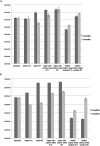Microbially induced corrosion of carbon steel in deep groundwater environment
- PMID: 26257707
- PMCID: PMC4513438
- DOI: 10.3389/fmicb.2015.00647
Microbially induced corrosion of carbon steel in deep groundwater environment
Abstract
The metallic low and intermediate level radioactive waste generally consists of carbon steel and stainless steels. The corrosion rate of carbon steel in deep groundwater is typically low, unless the water is very acidic or microbial activity in the environment is high. Therefore, the assessment of microbially induced corrosion of carbon steel in deep bedrock environment has become important for evaluating the safety of disposal of radioactive waste. Here we studied the corrosion inducing ability of indigenous microbial community from a deep bedrock aquifer. Carbon steel coupons were exposed to anoxic groundwater from repository site 100 m depth (Olkiluoto, Finland) for periods of 3 and 8 months. The experiments were conducted at both in situ temperature and room temperature to investigate the response of microbial population to elevated temperature. Our results demonstrate that microorganisms from the deep bedrock aquifer benefit from carbon steel introduced to the nutrient poor anoxic deep groundwater environment. In the groundwater incubated with carbon steel the planktonic microbial community was more diverse and 100-fold more abundant compared to the environment without carbon steel. The betaproteobacteria were the most dominant bacterial class in all samples where carbon steel was present, whereas in groundwater incubated without carbon steel the microbial community had clearly less diversity. Microorganisms induced pitting corrosion and were found to cluster inside the corrosion pits. Temperature had an effect on the species composition of microbial community and also affected the corrosion deposits layer formed on the surface of carbon steel.
Keywords: carbon steel; deep biosphere; microbial corrosion; sulfate reducing bacteria; terrestrial biosphere.
Figures







References
-
- Brody J., Kern S. (2004). Sodium boric acid: a Tris-free, cooler conductive medium for DNA electrophoresis. Biotechniques 36 214–216. - PubMed
-
- Carpén L., Maukonen J., Salo S. (2012). Accelerated corrosion of carbon steel and zinc in oxygen-free groundwater - Due to the microbiological activity? Paper Presented at the Nace International Corrosion Conference & Expo 2012 Paper No. C2012-0001397 (Salt Lake City, UT: Nace International; ).
LinkOut - more resources
Full Text Sources
Other Literature Sources

